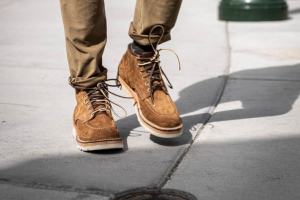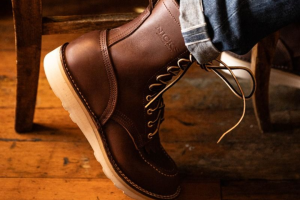Should You Buy Boots A Half Size Bigger? No, You Should Buy The Right Size
Boot sizes can get really confusing so people sometimes wonder if they should buy boots a half size bigger.
That really depends on whose boots you're buying...and not everyone's sizes are the same. We do recommend that you order a pair of Nick's Handmade Boots a half-size down from your normal shoe size, but that's because of how our boots are made and no one else's.
Unless a different sizing convention is implemented worldwide, it's going to stay that way for basically ever unless you have your boots and shoes completely made to order.
The real answer is you should order your boots the correct size for you. So let's explain how that works.
Should You Order Your Boots A Half Size Bigger? Only If The Bootmaker Lasts Run Small
Boot and shoe companies make boots or shoes to particular foot dimensions, which is assigned a numerical size. The dimensions that size fits is determined by the last, the mold that the boot or shoe is made around.
The issue is whether the last of a particular "size" is the same dimensions as your feet. Unfortunately, everyone in the industry uses different lasts. How those sizes are determined is anyone's guess...and they don't always tell you.
Some companies go by the sizes from a Brannock device.
The Brannock device formerly provided a frame of reference for consumers, meaning a shoe size would be the same as a Brannock measurement or the shoe or boot companies' sizes were relative to a Brannock measurement, say one size up from or a half-size down from it.
Over the years, use of the Brannock device has become less common and now a lot of shoe or boot makers just say "one size up" or "a half size down" or what have you.
Then you have classic US shoe sizes. These are based on the British sizing convention, but just add 1 to the size.
A size 12 US is a size 11 UK. US shoe sizes are supposed to go up by ⅛" to ¼" in length per half size; a size 4 is a 9-inch foot, and a size 12 is supposed to be a 12-inch foot. However, a size "12" last is not a "size 12" by US sizing conventions from all bootmakers.
Brannock sizes are ⅔" shorter than the last length is supposed to be, so a size 11 last - a men's size 9 in US sizes - is a 10 ⅓ in Brannock sizes.
So should you order a half-size up or down? That depends on what lasts the bootmaker is using, and they don't always provide that information or even context about their sizes.
Some work boots will fit "true to size" and others will be a half (or full) size "large." Ours tend to run a half-size large.
To Thine Own Boot Size Be True
We can tell you what size to order in our boots - we actually recommend you be fit and have your boots made to order for the best results - but we can't tell you what size to order for anyone else.
But something that can help you out is by measuring your feet. We're going to walk you through how to do that.
You can use our sizing guide template or a blank sheet of paper.
Our sizing guide will give you your Brannock size. Here's how you get your measurements.
Wear your typical socks, and place your heel in the heel cup on our sizing guide, and stand up. Measure the length of your left foot, then the length of your right foot on the form.
Then get a tailor's tape or use a bit of string. Measure the circumference of your feet at the widest part (the ball) of both feet, and write them both down. If you have to use string, use a tape measure or ruler to measure the length of the string after you've measured each foot.
That gives you your Brannock size.
If you can't print our form, here's how you get your foot size by direct measurement.
Get a blank sheet of paper. Wearing your normal socks, put one foot on the paper and stand up. Using a pen or pencil, trace the outline of your foot as close to it as possible. Then get another piece of blank paper, and do the same with the other foot.
Use a straightedge to draw a parallel line across the paper at the longest part of your foot. Measure from the heel to that line. That gives you the length of your foot.
Now measure across the widest part of the foot. That's your foot width.
If there's a difference between the two, use the larger one...but make sure to keep the measurements somewhere, in case you ever have a pair of boots or shoes made for you.
Once you have both measurements, you'll want to find what size length and width you are on a US size chart. Knowing your foot measurements, in Brannock sizes or in US sizes, at least gets you the understanding of what size your feet are. That will help you find boots and shoes that fit.
Of course, you can also always get fitted for boots to get the best possible results.




